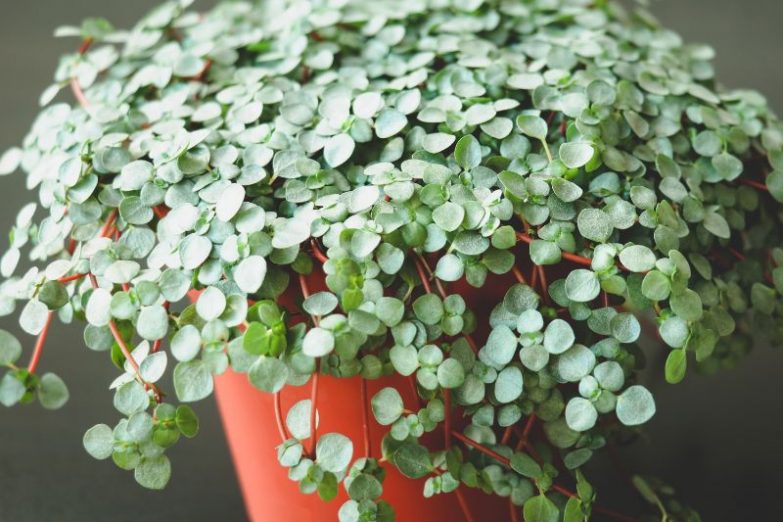As varied as the Pilea family is, the Pilea Glauca stands out for its cascade of mini-leaves sprinkled with silver “fairy dust.” This newly popular variety doesn’t have an official name yet – but, despite a few quirks, it already has many fans. Let’s look at everything you need to know about Pilea glauca care.
To provide good Pilea glauca care, place your plant in bright indirect light and grow in well-draining soil that stays slightly moist but never soggy: the top half-inch should dry out between waterings. Pilea glauca thrives with normal humidity, room temperatures, and light fertilization.
Pilea Glauca Care Summary
| Scientific Name | Not confirmed – Possibly Pilea libanensis |
| Common Name | Pilea Glauca, Pilea Silver Sparkle, Grey Baby Tears, Red-stemmed Pilea, Grey Artillery Plant |
| Light Requirements | Bright, indirect sunlight, with up to 1-2 hours of direct sunlight in the early morning or late afternoon. |
| Watering | Consistently moist soil. Water once the top half-inch of soil has dried out. Can be sensitive to water quality. |
| Soil | An equal mix of peat and perlite works well. Any mix that drains very well but retains a little moisture will be perfect. Here are some ideal pre-made potting mixes. |
| Temperature | 70ºF (21ºC) to 80º (26ºC). Not frost-tolerant. |
| Fertilizer | Fertilize monthly when actively growing with a balanced fertilizer. |
| Humidity | Medium to high humidity. |
| Flowering | Pilea glauca bears clusters of small, nondescript white, pink, or peach blossoms along its stems. |
| Pruning | Prune to remove dead or damaged leaves and to maintain plant size and shape. |
| Propagation | Stem cuttings root easily in soil or water. |
| Re-Potting | Pilea glauca only needs to be repotted when showing signs of becoming rootbound. |
| Diseases and Pests | Average susceptibility to most common houseplant pests. Diseases normally arise due to overwatering. |
| Toxicity | Non-toxic to humans and animals. |
| Where To Buy | Buy Pilea glauca online at Etsy (I buy most of my houseplants from Etsy). |
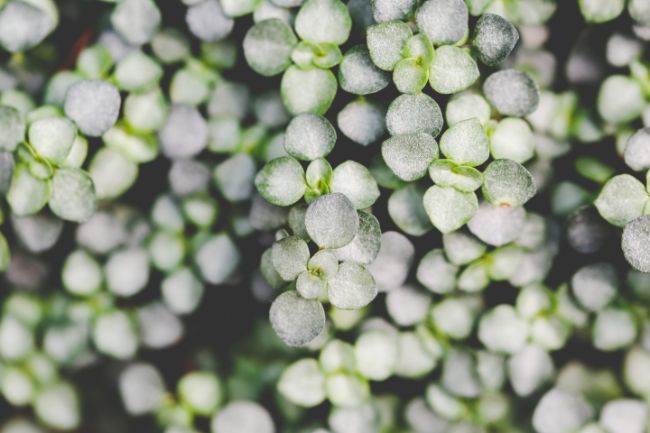
Pilea Glauca Overview
The Pilea Glauca has petite, oval, blue-gray leaves that shimmer with silvery powder that “sparkles” on a happy plant. The evergreen foliage grows on long, red-hued stems that can either create a thick groundcover or trail down from a hanging pot.
This attractive succulent was quickly adopted into the collectible category – yet no one seems to know exactly where it came from. It’s also termed the Pilea libanensis, but its name has not been formalized.
The plant is thought to originate anywhere from the Caribbean to Central America to as far south as Brazil. It has many common names:
- Pilea Silver Sparkle
- Grey Baby Tears
- Red-stemmed Pilea
It’s also called the Grey Artillery Plant because its tiny blossoms have stamens that burst open when watered.
Though it can stay smaller, the plant may grow to three feet high and matures in about three years. It’s versatile as a small potted desk plant, hanging centerpiece, or unique ground cover.
Pilea glauca care is similar to most Pileas. It likes bright conditions but can be a bit touchy about its watering regimen; otherwise, it’s easy-to-please indoors.
The plant is non-toxic to people or pets and makes an excellent candidate for a terrarium. The blue-green leaf color contrasts well with green foliage in any setting.
Pilea Glauca Light Requirements
Lot of bright, indirect light is required for good Pilea glauca care. As befits a succulent, the plant can take a few hours of direct morning sunshine and will welcome the extra lumens. Don’t go overboard: intense hot rays will quickly scorch the delicate leaves.
The Glauca is happy close to a bright window, though it will need some protection or distance from a southern exposure. It does well with artificial sources, too. The foliage will grow leggy or begin to drop off if conditions are too dim.
Watering
The Pilea Glauca needs slightly moist soil that never stays soggy or dries out completely. It’s not as tolerant of droughts as most succulents, but never allow the plant to sit in water! It is susceptible to root rot.
Only water once the top half-inch of soil has dried out. Check the medium: don’t rely on a schedule. You can use your finger or, if you become familiar with the weight of the pot, you can judge by picking up the container to decide if it’s time to water. Read this article for more helpful tips to tell when your houseplants need to be watered.
Thoroughly soak the soil when watering until water runs freely out of the drainage holes. Remember to let the excess water drain thoroughly each time you water and then empty drip trays and cachepots.
Yellow foliage and leaf loss can be caused by either under- or over-watering, so you may need to look deeper. Here are other symptoms:
Overwatering – Brown spots on the leaves or dark new foliage often mean overwatering. Leaves that droop and curl downward can also be signs. Check the roots for rot if you suspect overwatering as the cause.
Underwatering – Puckered, crisp or curling leaves indicate dry conditions … or a significant pest infestation.
Bottom watering is a good alternative method and ensures the soil is saturated without getting the leaves wet, which can increase the risk of disease. Place the plant’s pot in a larger reservoir of water and let it wick the moisture up. Don’t soak for too long, and drain thoroughly.
The plant needs less water in winter, just don’t let it dry out completely.
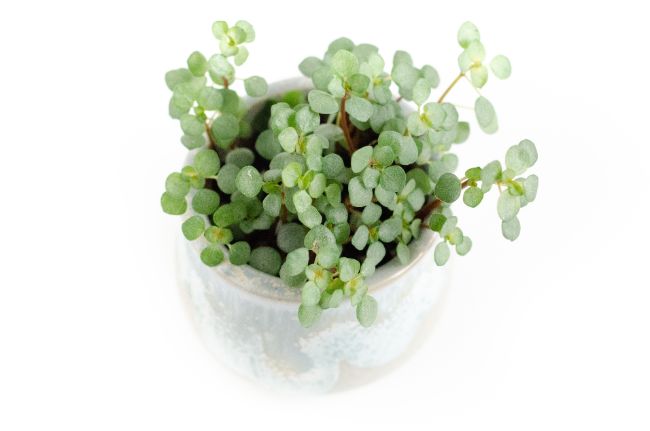
Water Quality
Pileas don’t like chlorinated water and can be sensitive to residual salts left by unused fertilizer. Rainwater, distilled water, or another purified source is ideal. Read more about water quality for houseplants here.
It’s best to let cold water reach room temperature before use.
Note: You may see white “dots” under the leaves caused by water with a high mineral or metals content. Using purified water eliminates this.
Pro Tip: An inexpensive aquarium dechlorinator can neutralize chlorine and chloramine content in tap water.
Soil For Pilea Glauca
Light, fluffy soil that drains well is the best potting medium. The soil should remain aerated even after a thorough watering.
Other than this, the plant isn’t fussy and does well in a variety of common soils. The Pilea glauca favors organic amendments, but a well-draining quality retail mix is usually fine.
One recommended soil recipe is a half-and-half mix of peat and perlite. Read more about choosing and making potting mix for your houseplants here.
Humidity
One of the great things about the Pilea Glauca is that it accepts normal household humidity in stride. Though it prefers high humidity, it can thrive in the somewhat arid conditions of the typical home.
There are limits, of course. A winter’s indoor heating can be a challenge, and you might need to make adjustments in a very dry climate.
If your plant’s leaves are developing crispy or brown edges, or appear dry and lackluster, either of these methods can make a minor yet important difference in humidity:
- Grouping Plants – Keeping the plant close to others lets them benefit from each other’s transpiration. The best combination is with other tropical plants.
- Humidity Trays – Placing water-filled trays near plants will slightly raise local air moisture through evaporation—just make sure to keep the trays filled. Many growers add pebbles to support the pot above the water line and then set the container on the tray.
Read more about the best ways to increase humidity for your houseplants here.
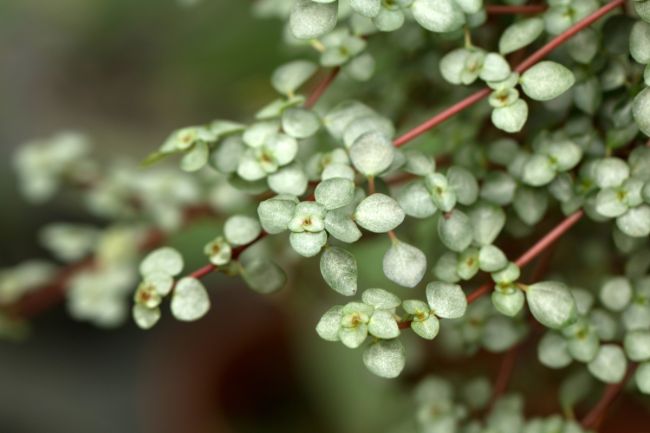
Pilea Glauca Temperature Requirements
Another thing that makes this Pilea a great houseplant is that it enjoys the home temperatures we prefer. It does well in a warm room of 70ºF (21ºC) to 80º (26ºC). Though not frost-tolerant, it can adapt to temperatures into the 50s (F).
The plant is evergreen (and ever-sparkly!), so you can keep temperatures the same year-round. Avoid extreme fluctuations and keep them out of drafts … in other words, don’t subject Glaucas to climatic conditions you wouldn’t like.
Fertilizing Pilea Glauca
Good Pilea glauca care should involve regular fertilizing, but it’s easy to overdo it. To avoid shock or root burn, small monthly doses are better than large seasonal ones.
Here are other fertilization tips:
- Use a balanced blend with an NPK ratio such as 10-10-10.
- Dilute the fertilizer to half or even a quarter of what the label recommends.
- A liquid fertilizer or one mixed with water is easiest to measure and apply, and it evenly distributes nutrition to the roots.
- Apply after watering or when the soil is already moist to avoid a rapid uptake of chemicals that can burn plant parts.
- Organic fertilizers are generally gentler than synthetics and aid soil microbial activity, too. However, organics may provide a less balanced nutrient profile.
- Soil composition has a role in how much fertilizer your Glauca needs. You may need to feed less if there’s organic material in the soil; a “soilless” mix may need more supplementation.
- To help avoid a buildup of residual fertilizer, flush the soil each watering by letting excess water flow out the drain holes. To flush if you’re bottom watering, consider adding a small amount of water to the top of the soil after soaking.
- Don’t feed during the cool season.
- Read more about fertilizing houseplants here.
Pilea Glauca Flowers
A healthy Pilea glauca bears clusters of small, nondescript white, pink, or peach blossoms along its stems. Blooming starts in late spring and happens sporadically throughout the growing season.
Though the flowers aren’t a highlight in themselves, they release a harmless shell burst of pollen into the air when watered. This surprise maneuver explains one of their common names: the Gray Artillery Plant.
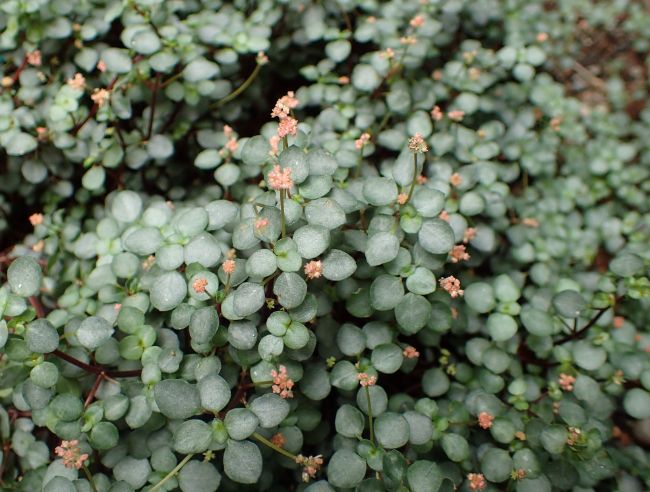
Basic Pruning
There are no special tricks to pruning a Pilea glauca. Grooming consists of cutting back dead or damaged leaves. Overgrowth can be thinned out as desired.
Pruning is more commonly needed when the plant is grown as a ground cover: thinning a tangled mat improves air circulation as well as appearance.
Don’t remove more than 20% of the plant at one time. Do major pruning in stages.
Cut the leaf stem where it attaches to the main branch. You can use shears or scissors, but always use sterile tools. Dipping them in isopropyl (rubbing) alcohol helps avoid spreading pathogens.
Repotting
Repotting is a stressful event for your plant, and can sometimes cause more problems with Pilea glauca care than it solves: it’s more stressful to them than being pruned. These tips will help make the operation a success:
- Don’t be in a hurry to repot a new arrival. Plan on waiting a year or even more before taking them from their nursery pot.
- Spring is the best time to repot in order to give the plant time to reestablish itself.
- Pileas don’t mind being slightly rootbound. Their root system isn’t large, however, so being rootbound isn’t often an issue.
- If the plant is healthy and growing, only repot every second or third year.
- It’s easier on the plant if you only repot up one size. If you keep the same pot, gently remove some old soil and renew it with a similarly composed fresh mix.
- Read more about repotting your houseplants here.
Propagation
Pilea Glaucas are easy to propagate! They root quickly and easily in either soil or water.
Start by cutting one- to two-inch stem pieces just above a node (the mound that leaves emerge from). Strip off the bottom few leaves.
Young growth is the best source for cuttings. Root multiple cuttings for fuller pot.
Rooting In Soil
This is the recommended method because it promotes strong roots from the outset.
- Use the same type of medium the mother plant is growing in. Smooth the soil and lay the segments on top.
- Ensure the cutting has good contact with the soil, but don’t press them down hard or cover them. Also, don’t pat down the soil around them: they thrive best in a loose, aerated medium. Note: Dipping the ends in rooting hormone is good insurance, though it’s not necessary.
- Water well and maintain light soil moisture.
- This is a time when high humidity is beneficial. Placing a clear plastic cover will help maintain ideal conditions. Rot or mold is a danger, so open the cover and ventilate the plant every day or two.
Rooting In Water
Putting a cutting in water takes away the guesswork about how the roots are developing. Its drawback is that roots grown in water may need to regrow once placed in soil.
- Place the cutting in clean, dechlorinated water. Purified is best. Keep the leaves dry.
- Provide good light and change the water every few days.
- Roots should emerge in one or two weeks. Transplant to soil once the roots are about an inch long.
Give them their own pot or add them to the mother plant’s container.
Growing Pups
It’s even easier to propagate the little baby plants that grow from an adult plant. These emerge from the soil or along the lower stems.
Leaving them in place will thicken the original planting, but you can also cut them off and treat them just like stem cuttings.
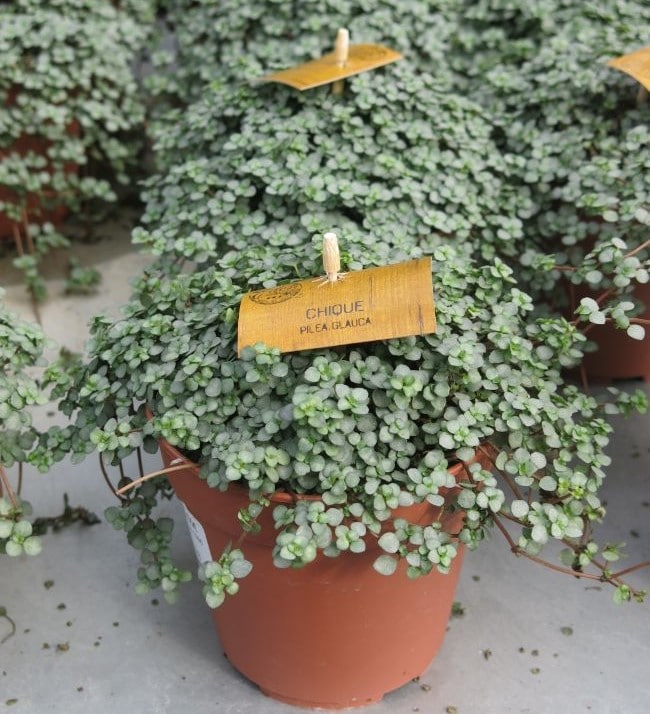
Pilea Glauca Care Tips
- If you see leggy stems, increase the light and make sure you’re watering correctly.
- Learn your plant’s language. The Glauca’s leaves tend to lose their sparkle when they need water.
- Trim leaves that stay wilted or discolored after a good watering.
- Yellow leaves are usually a problem with watering – if not, it could be a sign of undernutrition. Feed lightly and monitor the results.
- The plant will reduce leaf count if the light is too low: minimize losses by giving them bright conditions.
- Pilea glauca inevitably sheds older leaves, so don’t be alarmed by occasional losses.
- If you want a bushier plant, put the cut stems back in the soil after a trim. Propagation can be that easy!
- The Glauca makes a good plant in an animal vivarium, but wash the leaves before adding them to the environment.
Pro Tip: Mix mild dish soap with water in a bowl, then dip the plant upside down for a thorough cleansing. Rinse well!
Is Pilea Glauca Toxic To Pets And Humans?
Pilea Glaucas are safely non-toxic to both humans and animals – another reason they make great plants for a vivarium.
One Variety, Many Names
The so-called Pilea Glauca may not be the name botanists eventually settle on. Apparently the plant was named for its color by a retailer and the label stuck.
Some growers instead refer to this plant as a Pilea Glaucaphylla or a Pilea libensis. Another twist is the possible variation called the Pilea Glauca ‘Aquamarine’ … it may be the same plant, a cultivar, or an entirely different variety.
If nothing else, the plant’s multiple common names and foggy notions of its origins are a good example of why scientific naming is important.
Pests
Pilea Glauca care can be compromised by the usual role call of pests. The signs to look for include deformed foliage, mottled leaves, and overall stunting.
The first step is to determine which pest is attacking your plant:
Spider Mites – These tiny arachnids leave small spidery webs … they tend to congregate underneath leaves.
Mealybugs – This insect shows up as white, cottony patches, usually on leaves and in crevices. Another sign is sticky honeydew or black sooty mold on the lower leaves.
Root Mealybugs – Worse cousin to the ordinary Mealybug, these tiny pests are hard to spot. They leave their small and fuzzy white masses behind (mainly) on the roots. They are contagious, so isolate any plants you find them on.
Aphids – These common juice-suckers typically gather in herds under leaves, but they can be found elsewhere on the plant. Another telltale sign is the presence of honeydew.
Scale – Usually legless in their adult form, these insects look like colored bumps on leaves and stems. They’re easily mistaken for part of the plant. Rub to see if they come off.
One quick treatment is to dab rubbing alcohol over individuals or small groups; this kills on contact. Some growers spray affected plants with a mixture of a cup of rubbing alcohol to a quart of water.
If the infestation is well established, other effective treatments include light horticultural oil or insecticidal soaps. These are gentle, but their effectiveness wears off once they dry. They must contact the pest when wet.
Note: Root Mealybugs are hard to eradicate. You may have success adding diatomaceous earth (DE) to the soil to pierce their body armor – it does, however, need fairly dry soil to do the job.
Any treatment requires follow-up until the infestation has been resolved. If you’re desperate, you can try harsher pesticides; though introducing toxins to a household hanging basket or desk plant isn’t great, and you don’t want to use them in a vivarium.
For all these pests, the best prevention is a healthy plant!
Diseases
The main disease risk is wet leaves or soil. Excessive moisture opens the door to Leaf Spot, Botrytis, Southern Blight, and, most of all, root rot. Prevention is the best medicine: Pilea glauca doesn’t require high humidity, so it isn’t too hard to keep moisture at bay.
Avoid issues by providing well-draining soil, letting the top half-inch of soil dry between waterings, and keeping the leaves dry. If you think your Pilea Glauca may have a disease but you’re not sure what it is, read my article about common houseplant diseases to try to identify and fix the problem.

